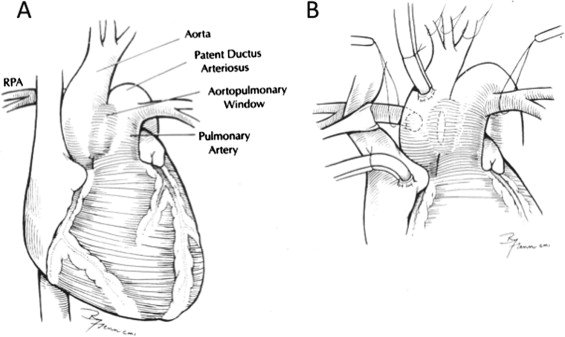What Are the Risk Factors Associated with Aortopulmonary Window?

An Aortopulmonary (AP) window refers to an unusual connection between the intrapericardial segments of the aorta and the pulmonary artery. This condition is exceedingly rare, comprising only 0.1% to 0.6% of congenital heart defects. It manifests as a spectrum, ranging from a small circular communication to a complete absence of the septum separating the aorta and pulmonary artery.
This abnormal connection can present in isolation or conjunction with other cardiovascular anomalies, including atrial septal defects, ventricular septal defects, coarctation of the aorta, interrupted aortic arch, or tetralogy of Fallot.
Exploring the diverse risk factors associated with the AP window can aid in implementing effective preventive strategies and early management approaches.
What Is an AP Window?
Aortopulmonary window (AP window) is a rare congenital heart defect where one or more of the pulmonary veins don’t connect normally to the left atrium of the heart. Instead, they connect to the right atrium or other nearby structures. This abnormality can disrupt blood flow and oxygenation in the body, potentially leading to various health complications.
Dr. Dinesh Mittal, a renowned cardiothoracic surgeon, specializes in treating complex heart conditions. With expertise in minimally invasive techniques, he is a leading authority on repairing the top AP window.
His innovative approaches ensure precise and effective treatment, providing patients with optimal outcomes and improved quality of life. Dr. Mittal’s dedication to excellence has earned him recognition as a pioneer in cardiac surgery.
What Are its Risk Factors?
The various factors that contribute to the development of this congenital heart defect are:
- Congenital Factors: AP window is primarily a congenital condition, meaning it’s present at birth. Factors such as genetic predisposition or maternal health during pregnancy can contribute to its development. Approximately 1 in 2,500 live births are affected by congenital heart defects, including AP window.
- Family History: Individuals with a family history of congenital heart defects may have a higher risk of developing an AP window. Genetic factors can play a significant role in predisposing individuals to such conditions.
- Maternal Health: Maternal health during pregnancy can influence fetal development, including the formation of the heart and blood vessels. Factors such as maternal diabetes, obesity, smoking, or exposure to certain medications or toxins during pregnancy may increase the risk of congenital heart defects like AP window in the offspring.
- Environmental Factors: Environmental factors, such as exposure to toxins or pollutants during pregnancy, may also contribute to the development of AP windows. Ensuring a healthy and supportive environment during pregnancy is crucial for fetal development and reducing the risk of congenital anomalies.
Dr. Mittal: “Lifestyle changes play a crucial role in managing AP window anomalies. Adopting a heart-healthy diet low in saturated fats and sodium can help regulate blood pressure and reduce strain on the heart. Regular exercise, tailored to your condition, improves cardiovascular fitness and overall well-being. Quitting smoking is paramount, as it reduces the risk of complications. Stress management techniques like meditation or yoga can also promote relaxation and lower blood pressure. By embracing these changes, you empower yourself to control your health better and enhance the effectiveness of medical interventions.”
What May Be the Preventive Measures?
While some risk factors for AP window are beyond our control, there are steps we can take to mitigate risk and promote overall heart health:
- Preconception and Prenatal Care: Ensuring optimal maternal health before and during pregnancy can reduce the risk of congenital heart defects in offspring. This includes maintaining a healthy weight, managing chronic conditions like diabetes, and avoiding harmful substances.
- Genetic Counseling: Individuals with a family history of congenital heart defects may benefit from genetic counseling. Genetic testing and counseling can provide valuable insights into the risk of passing on genetic anomalies to offspring and inform family planning decisions.
- Environmental Awareness: Avoiding exposure to toxins, pollutants, and harmful substances during pregnancy is essential for fetal development. Pregnant individuals should be mindful of their surroundings and take precautions to minimize exposure to potential hazards.
One of Dr. Mittal’s patients shared, “I was diagnosed with an AP window anomaly during my pregnancy, which was a terrifying experience. Dr. Mittal’s expertise and compassionate care guided me through every step of the journey. His thorough explanation of the condition and proactive approach to managing risk factors reassured me and my family. Thanks to Dr. Mittal’s skillful hands and dedication, I underwent successful surgery and now have a healthy baby boy. I’m forever grateful for his exceptional care.”
What Is the Cost of Treating Ap Window In India?
The cost of treating the Aortopulmonary (AP) window in India varies based on several factors, such as the severity of the condition, the chosen hospital, the expertise of the medical team, and any additional procedures required. On average, the cost can range from USD 4,000 to USD 7,000, equivalent to approximately INR 3,00,000 to INR 5,00,000.
Factors influencing the cost of AP Window treatment in India:
- The severity of the condition: The extent and complexity of the AP window can significantly impact the overall cost of treatment. More severe cases may require additional procedures or interventions, leading to higher expenses.
- Choice of hospital: The hospital’s reputation, facilities, and location can influence treatment costs. Renowned hospitals with state-of-the-art infrastructure may charge higher fees for AP window treatment.
- Medical expertise: The experience and expertise of the medical team, including cardiac surgeons, cardiologists, and anesthesiologists, can affect treatment costs. Specialized care from skilled professionals may incur higher fees.
- Additional procedures: In some cases, additional procedures such as cardiac catheterization, angioplasty, or open-heart surgery may be necessary to address complications or associated cardiac anomalies. The need for these procedures can contribute to increased treatment costs.
Overall, while the cost of treating AP window in India is relatively lower compared to other countries, it can still vary significantly depending on individual factors. Patients are advised to consult with healthcare providers and hospitals to understand the expected expenses and available treatment options comprehensively.
Conclusion
While AP window is a rare congenital heart defect, understanding the associated risk factors is crucial for early detection and intervention. By recognizing the factors that contribute to AP window and taking preventive measures, we can work towards reducing the incidence of this condition and promoting heart health for future generations. Remember, proactive steps toward health today can pave the way for a healthier tomorrow.
FAQs About AP Window
-
Can the AP window be completely prevented?
While some risk factors are beyond control, maintaining optimal maternal health and avoiding harmful substances during pregnancy can reduce the risk.
-
Is there a genetic test for the AP window?
Currently, there isn’t a specific genetic test for the AP window. However, genetic counseling can provide valuable insights for families with a history of congenital heart defects.
-
Are there specific symptoms of AP window in infants?
Infants may exhibit symptoms like rapid breathing, poor feeding, or cyanosis (bluish skin color). However, symptoms can vary, and some infants may not show noticeable signs early on.
-
Can AP window be diagnosed during pregnancy?
In some cases, prenatal ultrasound may detect an AP window. However, definitive diagnosis often occurs through echocardiography or other imaging tests after birth.
-
Is surgery the only treatment option for the AP window?
Surgery is typically the primary treatment for AP windows to repair the abnormal connection between the aorta and pulmonary artery. However, the treatment approach may vary based on the individual’s condition and medical recommendations.
Read More : What Causes a Hole in the Heart and How is it Treated?
